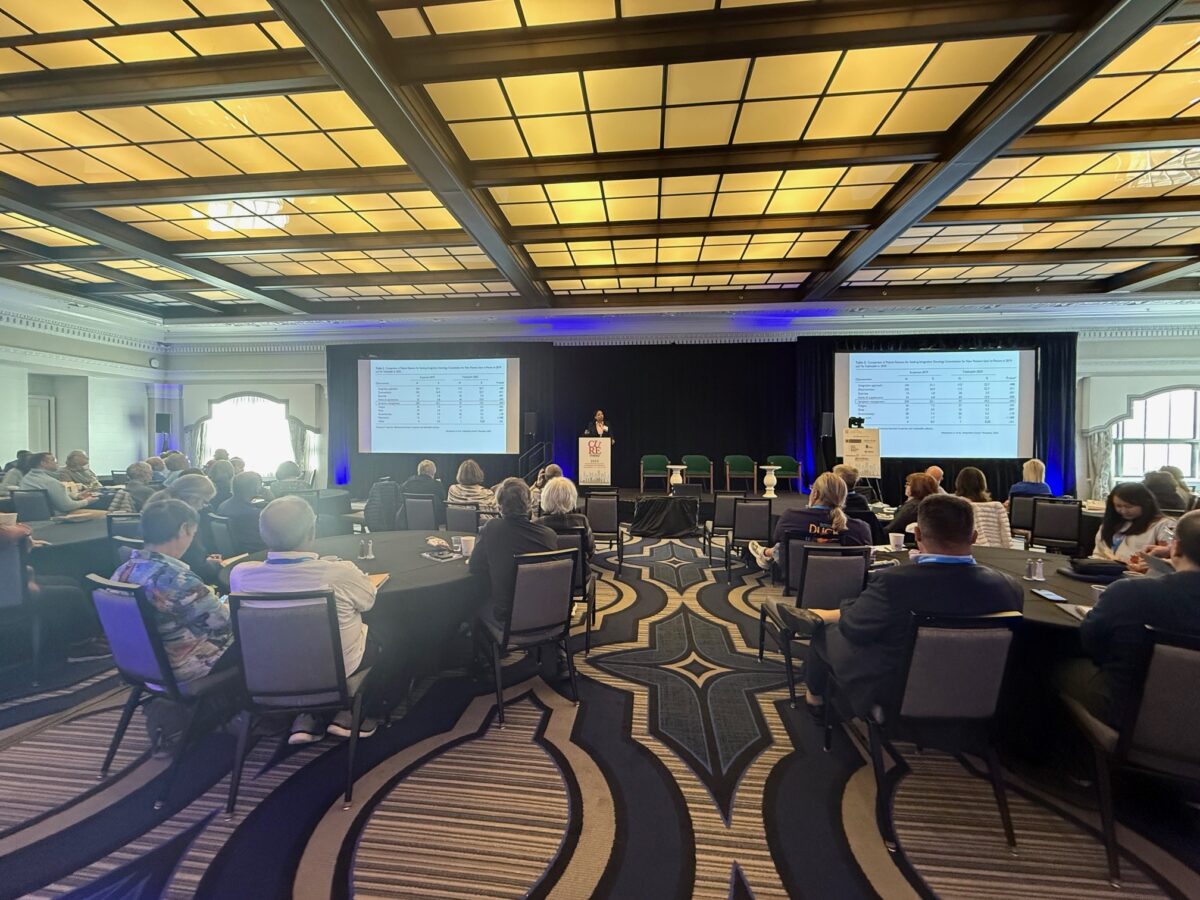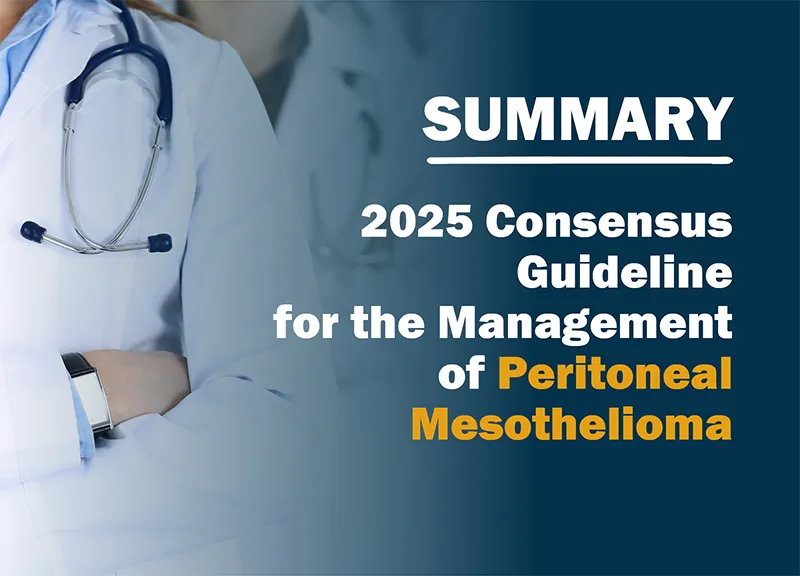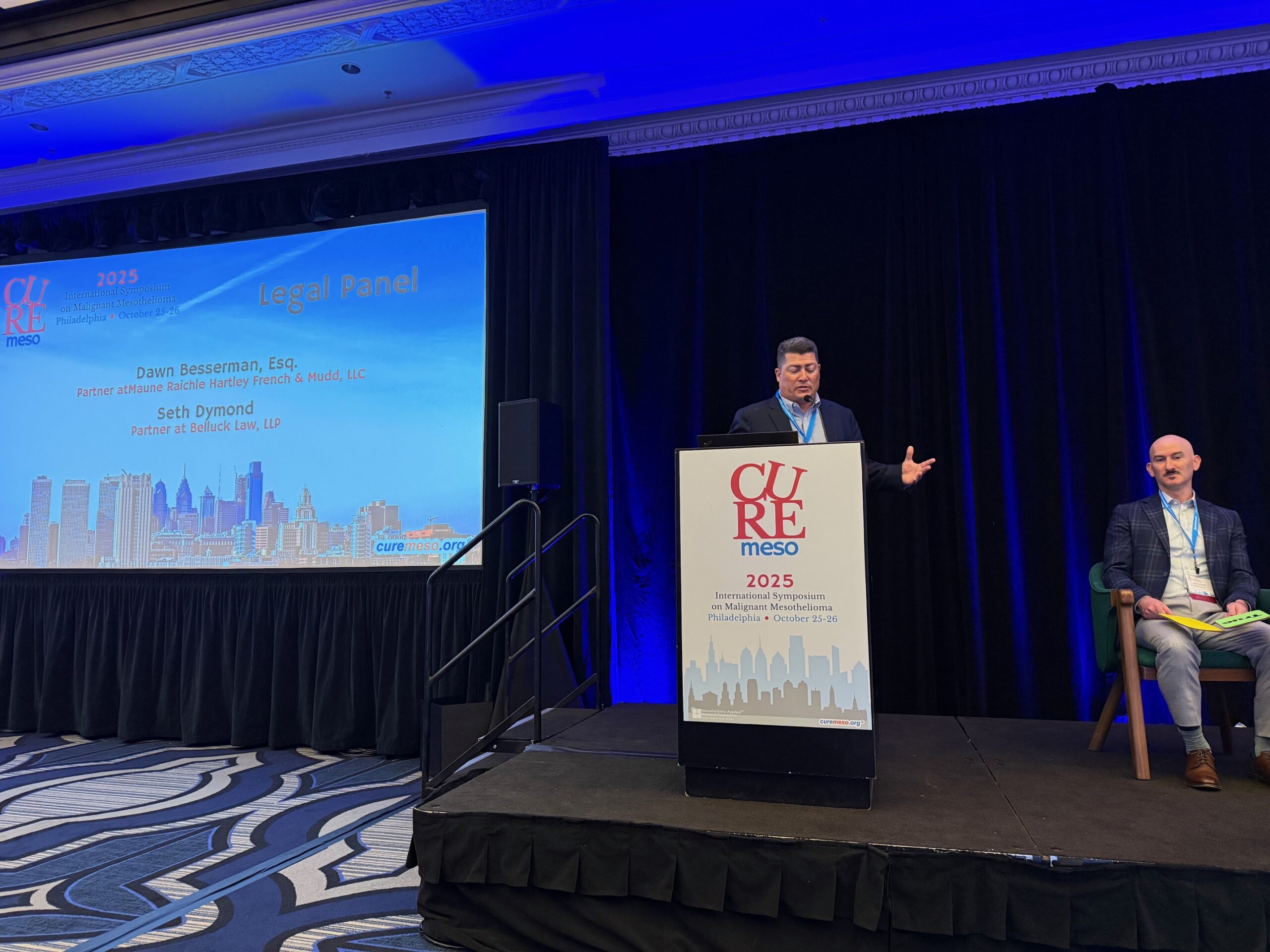Mesothelioma Help Cancer News

What Experts Revealed at iMig 2025 About the Next Wave of Mesothelioma Therapies
The 2025 gathering of the International Mesothelioma Interest Group (iMig) offered a powerful snapshot of where treatment for mesothelioma is heading, with a mix of clinical debate, scientific breakthroughs, and evolving therapeutic strategies. Several recurring themes emerged, notably around the role of surgery, advances in targeted therapies, and the expanding use of systemic treatments.
Surgery Under Scrutiny, but Still an Option in the United States
One of the central conversations revolved around the findings of the MARS2 trial, a UK-based multicenter study that randomized pleural mesothelioma patients (after two cycles of chemo) to either continue chemotherapy alone or undergo surgery followed by further chemo. The trial concluded that surgery provided no clear survival benefit.
These results shook long-held assumptions in the field and stimulated a strong re-evaluation of when surgery should be used. Experienced surgeons at the conference argued that the trial may not reflect optimal, real-world surgical practice citing concerns about patient selection and higher mortality in the surgical group.
Still, some high-volume mesothelioma centers (especially those handling 25+ cases per year) maintain that surgery can remain part of a broader multimodal treatment plan. In other words: though surgery may not cure, it could help extend life when combined with modern systemic therapies performed at experienced centers.
Because current systemic treatments yield a median survival around 18–24 months, combining refined surgical strategies with systemic therapy remains a goal. Trials incorporating immunotherapy either before or after surgery were spotlighted as especially promising.
A New Target: The Hippo Pathway and TEAD Inhibitors
Beyond surgical debates, researchers pointed to new molecular avenues such as the dysregulated Hippo pathway, which is disrupted in roughly 60% of mesothelioma cases. This makes it an attractive target for drug development.
Agents like Vivace VT3989 (a TEAD palmitoylation inhibitor) and IAG933 (which interferes with TEAD-YAP/TAZ interactions) are currently under development or in regulatory review for advanced solid tumors, including mesothelioma.
Preclinical data presented at iMig suggest that combining TEAD inhibition with immunotherapy may enhance immune cell infiltration into tumors, potentially improving effectiveness. However, the presence of Hippo pathway abnormalities alone isn’t yet a reliable predictor of who benefits.
This line of research could open new doors for patients, especially those whose tumors aren’t well served by existing chemo or immunotherapy regimens.
Systemic Therapies
Attendees reviewed the current arsenal of systemic treatments and looked ahead to future combinations. For patients who relapse, single-agent immunotherapy remains an option: for example, nivolumab has demonstrated improved progression-free survival compared with placebo, though overall survival gains are modest.
Other agents, such as pembrolizumab, show response rates in relapsed disease similar to older chemo drugs like gemcitabine or vinorelbine.
More importantly, several clinical trials are now exploring combinations intended to improve outcomes. For instance:
- The BEAT‑meso trial is testing standard chemo plus a blend of an immunotherapy agent and a VEGF inhibitor.
- The IND 227 trial compared chemo alone to chemo plus pembrolizumab, revealing particular benefit for non-epithelioid subtypes such as sarcomatoid or biphasic mesothelioma.
- Other trials include MIST 4 trial (atezolizumab + bevacizumab after prior chemo), RAMES trial (gemcitabine with ramucirumab vs. placebo), and investigations of antibody-drug conjugates like anetumab ravtansine, either alone or combined with immunotherapy.
New Hope for Aggressive Subtypes: Sarcomatoid and Biphasic Mesothelioma
Patients with sarcomatoid or mostly sarcomatoid tumors have long faced grim prognoses, given that those subtypes respond poorly to standard treatments. Results from studies in recent years, though, have shown growing evidence that immunotherapy can meet a critical need here.
One particularly important development: in nonepithelioid pleural mesothelioma, the combination of chemotherapy with pegargiminase significantly improved outcomes in the ATOMIC‑meso trial. According to the data discussed, pegargiminase caused a modest increase in overall survival (about 1.6 months), but more strikingly, quadrupled 3-year survival compared to chemotherapy alone. The drug works by starving tumor cells of arginine, a nutrient certain mesothelioma cells can’t produce on their own, which weakens their growth ability.
While immune-based regimens remain powerful, they can also lead to unpredictable side effects; in such cases, pegargiminase represents a promising alternative or addition for individuals who may not tolerate immunotherapy or who are not candidates for immunotherapy.
What’s Next
Discussions at iMig underscored a balance between realism and optimism. On one hand, the field recognizes the many hurdles left to overcome as mesothelioma remains difficult to treat, and no single approach is a silver bullet. On the other, there is clear momentum toward better patient outcomes, built on improved surgical techniques, deeper biological understanding, novel drug targets, and smarter combination therapies.
The conference reaffirmed that the future of mesothelioma care likely lies in personalization: matching treatment strategies (surgery, chemo, immunotherapy, targeted agents) to tumor biology, disease subtype, and patient condition. With ongoing clinical trials and evolving research, there is growing hope that the standard of care will continue to shift giving patients more options and, ultimately, much more time.

Could adding a COVID-19 vaccination to immunotherapy lead to better outcomes for mesothelioma?
A new study in Nature has sparked excitement among cancer researchers, revealing that immune therapies like nivolumab (Opdivo) and ipilimumab (Yervoy) may be more effective when paired with an mRNA-based COVID-19 vaccine. These immune checkpoint inhibitors work by releasing the natural restraints on immune cells, allowing them to recognize and attack cancer more efficiently.
The research highlights a surprising connection between mRNA vaccines, originally designed for COVID-19, and the performance of immune checkpoint inhibitors (ICIs). Scientists observed that administering an mRNA vaccine encoding the SARS-CoV-2 spike protein triggered strong immune activation, including a rise in type I interferons and stimulation of innate immune cells. This immune boost enhanced the priming of CD8+ T cells which act as key players in attacking tumor cells.
In animal studies, combining the vaccine with ICIs led to far greater tumor shrinkage than either therapy used alone. Remarkably, this effect was also seen in so-called “cold” tumors, which are usually resistant to immunotherapy.
The human data mirrored these results. Patients with advanced non-small cell lung cancer (NSCLC) or melanoma who received an mRNA COVID-19 vaccine within 100 days of starting ICI treatment showed notably improved overall survival compared to those who had not been vaccinated during that window.
Tumor samples from these patients also revealed higher PD-L1 expression after vaccination, suggesting that the vaccine may help make tumors more visible to the immune system and more responsive to checkpoint inhibition.
These findings suggest a new way of thinking about vaccines as not just as tools for preventing infection, but as potential enhancers of cancer immunotherapy. While the study did not specifically focus on mesothelioma, the results are of great interest to mesothelioma researchers, as immune checkpoint inhibitors have already offered improved outcomes over traditional therapies, though their overall benefit remains limited.

Veterans Day 2025: Asbestos Exposure and Mesothelioma Among Veterans
For much of the 20th century, asbestos was used throughout the U.S. military branches for its heat resistance and insulating properties. It could most often be found in ships, vehicles, aircraft, barracks, and bases. While it helped protect equipment, it also exposed countless service members to asbestos, a dangerous substance known to cause serious diseases such as mesothelioma, lung cancer, and asbestosis.
Why are veterans at a higher risk?
The military relied heavily on asbestos as a durable, inexpensive, and fire-resistant material. As a result, veterans from nearly every branch (Navy, Army, Marine Corps, Air Force, and Coast Guard) may have been exposed during their service. Navy veterans are among the most frequently affected because of the extensive use of asbestos on ships.
According to the U.S. Department of Veterans Affairs (VA), asbestos exposure was especially common among those who worked in:
- Shipyards and naval vessels – where asbestos insulated pipes, boilers, and engines
- Aircraft maintenance – involving gaskets, valves, and insulation materials
- Vehicle repair – especially when replacing brakes or clutches
- Construction and carpentry – including roofing, flooring, and cement work
- Power plants and mechanical rooms – with turbines and other heat-generating machinery
Long-term health effects
Asbestos-related diseases often take decades to appear after exposure. Many veterans who were exposed in the 1960s, 70s, or 80s are only now being diagnosed. When asbestos fibers are inhaled or swallowed, they can lodge in the lining of the lungs, abdomen, or heart, leading to inflammation and, over time, serious illness.
Common conditions linked to asbestos exposure include:
- Mesothelioma: a rare and aggressive cancer of the lining of the lungs or abdomen
- Lung cancer: which can develop even in those who never smoked
- Asbestosis: a chronic lung disease that causes scarring on lung tissue and breathing difficulties
Symptoms often appear gradually and can include shortness of breath, chest or abdominal pain, fatigue, or unexplained weight loss. Veterans who notice these symptoms should tell their healthcare providers about any possible asbestos exposure during their service.
Support and Resources for Veterans
Veterans diagnosed with asbestos-related diseases may be eligible for VA health care and disability benefits. These benefits recognize the connection between military service and asbestos exposure and can help cover treatment and related expenses.
In addition to VA benefits, veterans and their families can turn to a range of organizations and support networks that focus on asbestos-related illnesses. These groups provide education, emotional support, and guidance for navigating complex medical and benefit systems.
Raising Awareness
Every veteran deserves to understand the risks they faced in service and to receive care if those risks led to illness. Sharing information about asbestos exposure helps others recognize symptoms earlier and seek proper medical attention.
If you or a loved one served in the military and have been diagnosed with mesothelioma or another asbestos-related disease, you are not alone. Learning about the connection between asbestos and military service is the first step toward getting help, treatment, and support.

International Symposium on Malignant Mesothelioma Brings Together Patients and Clinicians in Philadelphia
The annual International Symposium on Malignant Mesothelioma, hosted by the Mesothelioma Applied Research Foundation, brought together leading researchers, clinicians, patients, and advocates in Philadelphia this weekend for two days of groundbreaking discussion, collaboration, and support centered on advancing mesothelioma research and care.
MESOTHELIOMA TREATMENT AND SCIENCE
For pleural mesothelioma patients, the Pleural Tumor Board Panel provided information about available treatment options but also covered the rationale employed by multidisciplinary teams when deciding the best course of action for a patient. Experts on the panel included:
- Melina Marmarelis, MD, University of Pennsylvania (Medical Oncologist)
- Adam Bograd, MD, Swedish Cancer Institute (Thoracic Surgeon)
- Mehmet Altan, MD, MD Anderson Cancer Center (Medical Oncologist)
- Michael Offin, MD, Memorial Sloan Cancer Center (Medical Oncologist)
The panel walked attendees through two real cases, illustrating how multidisciplinary teams make complex decisions about personalized treatment plans. In mesothelioma there are few approved treatments available, and their efficacy largely depends on the cellular and molecular features of the tumor, so some disagreement in approach is to be expected. Overall, the experts agreed with front line therapy of immunotherapy for non-immune compromised patients and chemotherapy for those not eligible for immunotherapy. Surgery (pleurectomy decortication) can be considered as a treatment option in certain circumstances, namely an epitheliod cell type, and when the patient is fit enough to withstand the stress and recovery of such an intricate operation. Treatment before surgery (known as neoadjuvant treatment) and treatment after surgery (known as adjuvant treatment) with the same chemotherapy and immunotherapy agents is typically recommended. For sarcomatoid patients, immunotherapy is the best option, and those patients are generally not surgical candidates. Surgery can also be an effective tool for palliation of pain and difficulty breathing.
For peritoneal mesothelioma patients, the Peritoneal Tumor Board Panel was structured to provide treatment information and an understanding of rationale for those treatments. That panel included:
- Jason Foster, MD, University of Nebraska (Peritoneal Mesothelioma Surgeon)
- Hedy Kindler, MD, University of Chicago Medicine (Medical Oncologist)
- Michael Offin, MD, Memorial Sloan Kettering Cancer Center (Medical Oncologist)
- Georgios Karagkounis, MD, Memorial Sloan Kettering Cancer Center (Peritoneal Mesothelioma Surgeon)
Unlike pleural mesothelioma, peritoneal mesothelioma does not have a set standard treatment outlined and agreed upon by experts nor is there a staging system that would standardize the results. However, it is generally accepted as best practice to perform cytoreductive surgery followed by HIPEC (hyperthermic intraperitoneal chemotherapy). Additionally, systemic chemotherapy and immunotherapy are also available to these patients.
WHAT’S NEW WITH CLINICAL TRIALS AND TARGETED THERAPIES
Beyond treatment updates, the symposium also highlighted advances in imaging and clinical trials shaping the future of mesothelioma care.
Dean Fennell, MD, PhD, University of Leicester (Medical Oncologist) provided an overview of emerging and recently completed clinical trials. Beyond large, systemic treatment studies, mesothelioma patients have the option of enrolling in several targeted treatment clinical trials, eligibility for which depends on the molecular features of their tumors.
THE ROLE OF AI IN MEDICAL IMAGING
As the world adjusts to the sudden advent of artificial intelligence (AI), the medical field has already been working to galvanize the benefits of machine learning in area where consistency is paramount. Medical imaging is one of those areas. The presentation by Kevin Blyth, MD, University of Glasgow looked at new ways in which AI can assist doctors by enhancing accuracy of interpretation in imaging interpretation.
SUPPORT, ADVOCACY, AND LEGAL INSIGHT
Social interaction and support groups are a big part of this conference, providing attendees the ability to connect with others who have undergone similar challenges. Patients and their families had numerous opportunities to interact and share information informally, but other non-medical panels also helped with that.
- Legal Panel: this session featured Seth Dymond, Esq., a partner attorney with Belluck Law, LLP who participated in a rapid-fire Q&A and provided additional clarification on legal issues as they relate to asbestos and mesothelioma litigation.
- Clinical Trials Patient Panel: unlike the sessions featuring medical professionals, this session put forth patients who participated in clinical trials to share their experiences with enrollment and their ability to tolerate treatment and side effects.
- Survivorship Patient Panel: panelists discussed their experience after treatment as they related to physical and mental health
The symposium closed with a sense of optimism, solidarity, and newly acquired friendships underscoring the Foundation’s mission to connect science, care, and community. Recordings of additional sessions are available on the Mesothelioma Applied Research Foundation’s website and YouTube channel.
SPONSORSHIPS
Belluck Law, LLP was one of the top sponsors of the conference. Belluck Law, LLP, is a premier national firm specializing in mesothelioma and asbestos cases. With offices in New York City and across the state of New York in Albany, Rochester, Woodstock, Gloversville and offices in Maine, Massachusetts, and New Jersey. The firm has recovered over $1 billion in compensation on behalf of its clients. The firm’s attorneys have been recognized by Best Lawyers, Best Law Firms, SuperLawyers, Martindale Hubbell and other peer and third-party attorney evaluators.
In September of 2025, the firm obtained an $83 million verdict on behalf of a client exposed to asbestos by working with clay, and in earlier in the same month, the firm obtained a nearly $12.25 million verdict on behalf of another client who was exposed to asbestos by living near a talc mine.

Summary of the 2025 consensus guideline for the management of peritoneal mesothelioma
It is estimated that approximately 3,000 people are diagnosed with mesothelioma each year in the United States. Compared with roughly 230,000 diagnoses of lung cancer, mesothelioma is a very rare cancer. Pleural mesothelioma, which is mesothelioma of the lining of the lung, is by far the most commonly occurring variety of this cancer. Peritoneal mesothelioma, which is mesothelioma that affects the lining of the abdominal cavity, sees 300-400 new diagnoses each year in the United States. For this reason, randomized clinical trials for peritoneal mesothelioma are not feasible. However, despite a lack of approved standard treatment for this type of mesothelioma, experts have come together to identify areas of consensus in what constitutes the best practices in treatment of peritoneal mesothelioma. This compilation of guidelines is an update on a previous iteration from 2018.
The manuscript by Brown LM, Wilkins SG, Bansal VV, Su DG, Gomez-Mayorga J, Turaga KK, Gunderson CG, Lee B, Nash GM, Hays JL, Raghav KP, Husain AL, Kluger MD, Zauderer MG, Kindler HL, Alexander HR; Peritoneal Surface Malignancies (PSM) Consortium Group. Consensus Guideline for the Management of Peritoneal Mesothelioma https://brand.msu.edu/Downloads. Ann Surg Oncol. 2025 Jun 25. doi: 10.1245/s10434-025-17358-x. Epub ahead of print. PMID: 40560500, was published in June of 2025.
The collection of these guidelines was made possible by ongoing research efforts, which include clinical trials. As the authors eloquently state:
“Clinical trial enrollment should be considered at every step of treatment, not only to expand our knowledge of this rare disease but also to enhance patient care opportunities.”
Major updates
- This iteration of treatment guidelines for peritoneal mesothelioma emphasizes the importance of a multi-disciplinary approach, particularly in a pre-operative setting.
- Additionally, psychosocial interventions should be incorporated as part of patient care throughout treatment and after.
- For benign pathologies such as peritoneal inclusion cysts and well-differentiated papillary mesothelial tumors, the new best practice is to observe while reserving surgical resection for patients with symptomatic, recurrent, diffuse, or microinvasive disease. Imaging surveillance type and specific treatment should be based on risk stratification.
2025 Consensus Guidelines for clinicians and patients navigating PeM diagnosis, treatment, and follow-up.
Diagnosis & Initial Assessment
-
Multidisciplinary Evaluation
- Engage surgical oncology, medical oncology, radiology, pathology, and social work.
-
Imaging
- CT or MRI of abdomen/pelvis with contrast.
- CT chest to check for spread.
- PET scan: optional in select cases.
-
Biopsy
- Prefer laparoscopic biopsy to assess tumor extent.
- Avoid cytology alone (often inadequate).
-
Pathology & Biomarkers
- Determine histologic subtype: epithelioid, biphasic, sarcomatoid.
- Test for Ki-67, PD-L1, ALK.
- Tumor somatic sequencing is not currently part of the protocol. Additional research is needed to determine clinical usefulness.
Benign or Borderline Disease
-
Asymptomatic, Localized Disease (e.g., WDPMT)
- Observation with imaging every 6 months.
-
Symptomatic or Progressive Disease
- Consider surgical resection.
- Repeat biopsy to rule out malignancy.
- Systemic therapy not routinely recommended.
Malignant Peritoneal Mesothelioma (PeM) Management
Risk Stratification:
- Low-Risk:
- Resectable disease.
- Favorable histology (epithelioid), younger age, good performance status.
- Treatment: Upfront CRS + IPCT.
- Intermediate-Risk:
- Larger tumor burden or borderline operability.
- Treatment: Neoadjuvant chemotherapy or immunotherapy, then reassess for surgery.
- High-Risk:
- Unresectable, poor performance status, aggressive histology.
- Treatment: Systemic therapy only (chemo or immunotherapy).
Systemic Therapy Options
- Epithelioid:
- First-Line: Pemetrexed + cisplatin/carboplatin ± bevacizumab OR nivolumab + ipilimumab.
- Second-Line: Switch to the other class (e.g., ICI if chemo first).
- Biphasic/Sarcomatoid:
- First-Line: Nivolumab + ipilimumab.
- Consider chemo if ICI is ineffective or not tolerated.
- Note: Clinical trial participation is encouraged at all stages.
Surgical Principles (CRS + IPCT)
- Goal: Complete cytoreduction (CC-0 or CC-1).
- May require resection of multiple abdominal organs.
- Requires expert surgical team.
- Consider palliative debulking in select cases.
Surveillance Protocol
- Benign Disease:
- CT/MRI every 6 months (first 2 years), then annually.
- Post-Treatment PeM:
- Every 3 months (years 1-2),
- Every 6 months (years 3-4),
- Annually thereafter.
Patient Support & Quality of Life
- Early referral to palliative care.
- Access to peer support and survivorship resources.
- Consider mental health and rehab services.
Conclusion
Management of PeM is highly individualized, requiring a multidisciplinary team and frequent reassessment. The consensus guideline promotes evidence-informed care and supports ongoing research to optimize treatment and survivorship outcomes.
Free Mesothelioma Patient & Treatment Guide
We’d like to offer you our in-depth guide, “A Patient’s Guide to Mesothelioma,” absolutely free of charge.
It contains a wealth of information and resources to help you better understand the condition, choose (and afford) appropriate treatment, and exercise your legal right to compensation.
Download Now


